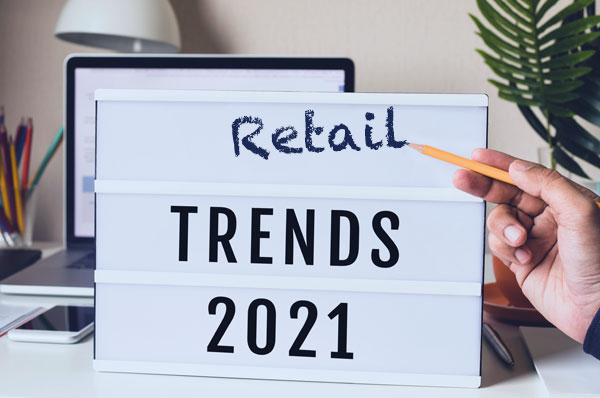Here we give you five trends and one must-have, that retailers need to be aware of.
1. Omnichannel retail remains significant
The need for retailers to adopt an omnichannel approach is perhaps the most enduring retail trend of recent years. While it’s not a new idea by any means, the ability to connect online and offline retail elements quickly and creatively is vital to the success of retailers in 2021.
Omnichannel is becoming the default position for modern retailing. But it’s also where a lot of retailers feel they are lacking due to not having achieved true integration between the different aspects of their business. Yet with Covid-19 likely to still be a prominent element of the coming year retailers need to get their omnichannel operations right in order to be able to capture all possible customer sales, as well as to grow them. Retailers that continue to drag their heels on omnichannel may struggle to manage any permanent shifts in customer behaviour as a result of the pandemic. Those that have invested in a robust omnichannel strategy will be in the best position to deal with whatever comes next.
2. E-commerce will evolve to be more fun
E-commerce really came into its own in 2020. With the double influence of coronavirus and customer appreciation for convenience, e-commerce’s recent gains are only set to increase. However, e-commerce in 2021 needs to evolve beyond the purely functional to provide the entertainment element that physical retail has so long offered. Shoppers have expressed dissatisfaction with online shopping experiences that make it too easy to just keep buying the same products over and over. <
This year e-commerce needs to introduce discovery and fun without adding barriers to the buying process. For example, rather than long lists of results retailers could use interactive elements like swiping or quizzes to help customers quickly share their preferences and then see select recommendations based on those.
3. Resale will continue to grow
Another growth sector from 2020 that is carrying over into the new year is retail resale. Resale’s growth over the last year or two is largely consumer-driven, as opposed to by any specific industry or brand, which makes it particularly vital for retailers to address.
Accessibility is one growth driver thanks to the dedicated resale apps. Sustainability concerns is another. Financial pressures, which have been increased by the Covid-19 pandemic’s associated redundancies, furlough schemes and company collapses, are a persistent factor.
While retail resale was initially peer-to-peer focused, the potential size of the market has prompted retailers to launch their own schemes. Second-hand clothing sales platform ThredUP predicts that second-hand fashion will be worth $64 billion in the next five years. As such, this year we will see the adoption of resale by more retailers than ever, not only in fashion but other sectors such as homeware, outerwear, sportswear and furniture.
4. Experiential retail will take a different approach
Many are heralding experiential retail as the big trend again for physical stores in 2021 but the reality is a little more nuanced. There is certainly pent-up demand from consumers for out of the home entertainment and socialisation, which experiential stores can help to fulfil.
However, the coronavirus pandemic is ongoing and it’s hard to predict when ‘normality’ maybe realised. Equally, customers may be initially cautious about throwing themselves back into highly tactile large group activities.
A different approach to experiential retail is likely to thrive instead. Last year many retailers turned to technology to manage customer numbers in stores and in the process improved the experience overall. This includes schemes like virtual queuing apps, bookable shopping appointments and drive-up retail. These all offer a new type of experience that prioritises the customer in terms of their time and the level of service. There’s no reason to believe that customers won’t want to retain these services following the pandemic. It’s likely that virtual queuing, appointment shopping and other new offerings will become the retail standard of the future.
5. Live streaming will become the norm
Selling via live streaming may have taken off last year in the wake of the coronavirus pandemic, but 2021 could be the year it becomes an integral part of the retail industry mix in the same way that pop-ups have.
Live stream shopping bridges the best of online and offline shopping – it has the ‘live in person’ immediacy of physical retail and the convenience and reach of e-commerce. Watching live streamed content that can be shopped in real-time provides an entertainment element that is often missing from e-commerce. It can be used to sell almost anything from clothes to food to pearls. It’s a trend that is perfectly aimed at a world where large parts of the population have become comfortable with video communication tools over the last 12 months.
But it’s also future proof in that it is not only appropriate for the current global situation.The flexibility of this trend is so great that we’re now seeing brands putting video facilities directly into stores as with BeautyCounter’s new space in Los Angeles. This helps retailers make more of their physical assets by using them as broadcast spaces as well as shopping destinations.
Flexibility is the key
The biggest retail trend of 2021 is directly informed by the events of 2020.
More than ever retailers need to approach their businesses with an adaptive mindset. Flexibility is key in a world where you don’t always know what is coming or how far-reaching the impact of events may be.
Retailers need to build in the ability to pivot quickly. This means adopting a digital infrastructure that can be adapted, modular store formats that lend themselves to different layouts and service offerings and embracing data to make quick decisions.
The more flexibility a retailer has in the way they do business, the more resilient they are in dealing with whatever comes next – even the surprises.



.jpg?width=800&height=800&name=blog-jack-nrf-25%20(1).jpg)






